For many, the 2010s will go down as one of the most turbulent decades in living memory.
From years of swingeing cuts under the Conservative government’s programme of austerity to the country’s decision to leave the EU, the past 10 years have ushered in changes that have left the UK a very different place than it was at the start of 2010.
At the centre of it all has stood the NHS. As wave after wave of change has hit the country, the health service – one of the UK’s most-treasured institutions – has also been reshaped.
But how the NHS has changed in the past 10 years – and what it means for the millions of people who rely on it – is up for debate.
During the general election campaign, the NHS was one of the main battlegrounds. From photos of a sick child sleeping on the floor to promises about new nurses, politicians of all parties were quick to give their take on how the NHS has fared in recent years – and what needs to be done next.
Confused about what to believe? Here are seven statistics which show some of the ways the NHS has changed this decade.
Funding Increased – But Not As Quickly As In The Past
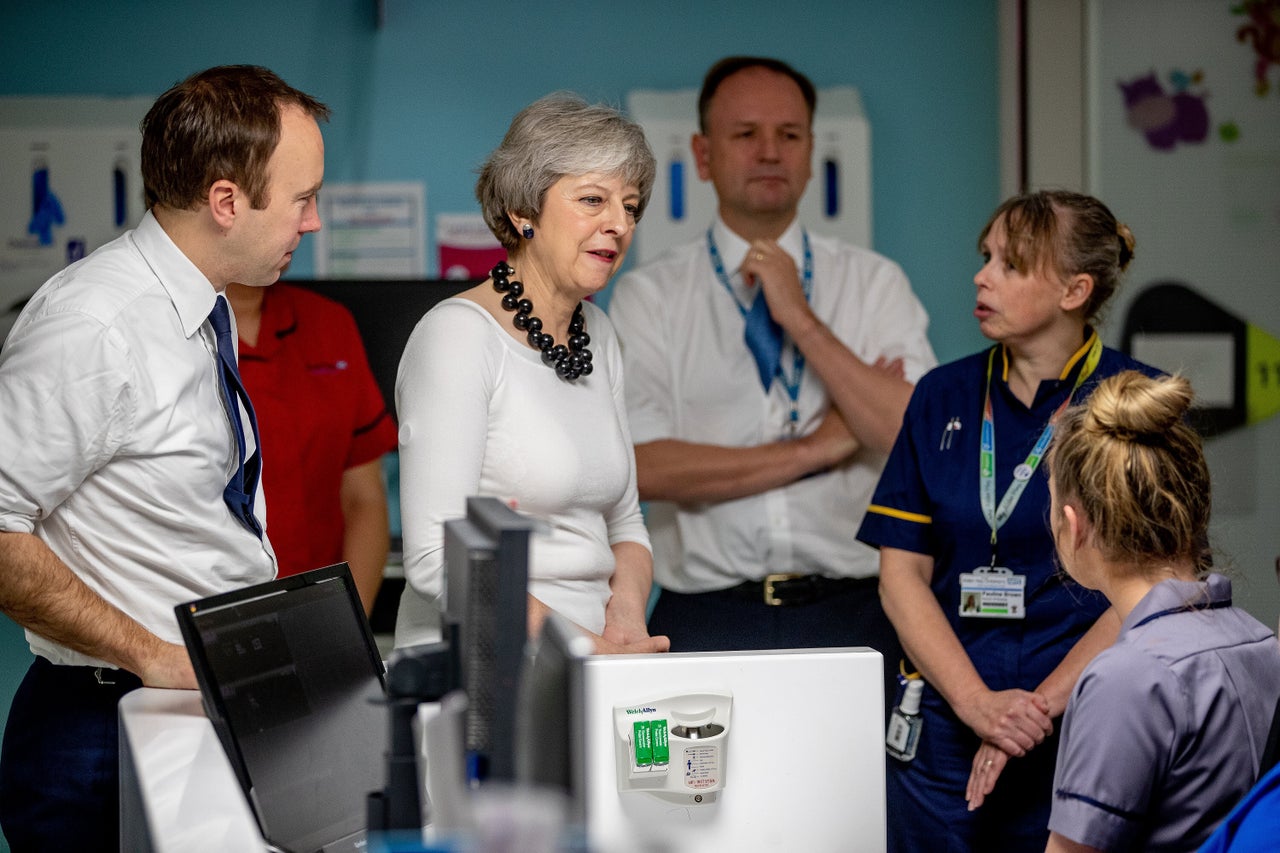
Austerity may have dominated the 2010s, but research from the King’s Fund shows that the Department for Health and Social Care’s budget increased each year between 2009/10 and 2018/19, rising from £116.8bn to £132.9bn in real terms 2019/20 prices.
To mark the 70th anniversary of the NHS last year, the government also announced a new funding package for the health service in England, promising to increase the annual budget in real terms by £20.5bn by 2023/24.
So why have people so worried about the health of the NHS coffers? Part of the reason is, while the budget has continued to get bigger, funding growth has slowed considerably.
In the first 70 years of the NHS, the average annual budget rise was 3.7%. However, between 2009/10 and 2018/19, the average funding growth each year was just 1.5%.
Even with the government’s new cash boost for the NHS, annual growth will still only be 3.4%.
A&E Waiting Times Reached The Worst Levels On Record
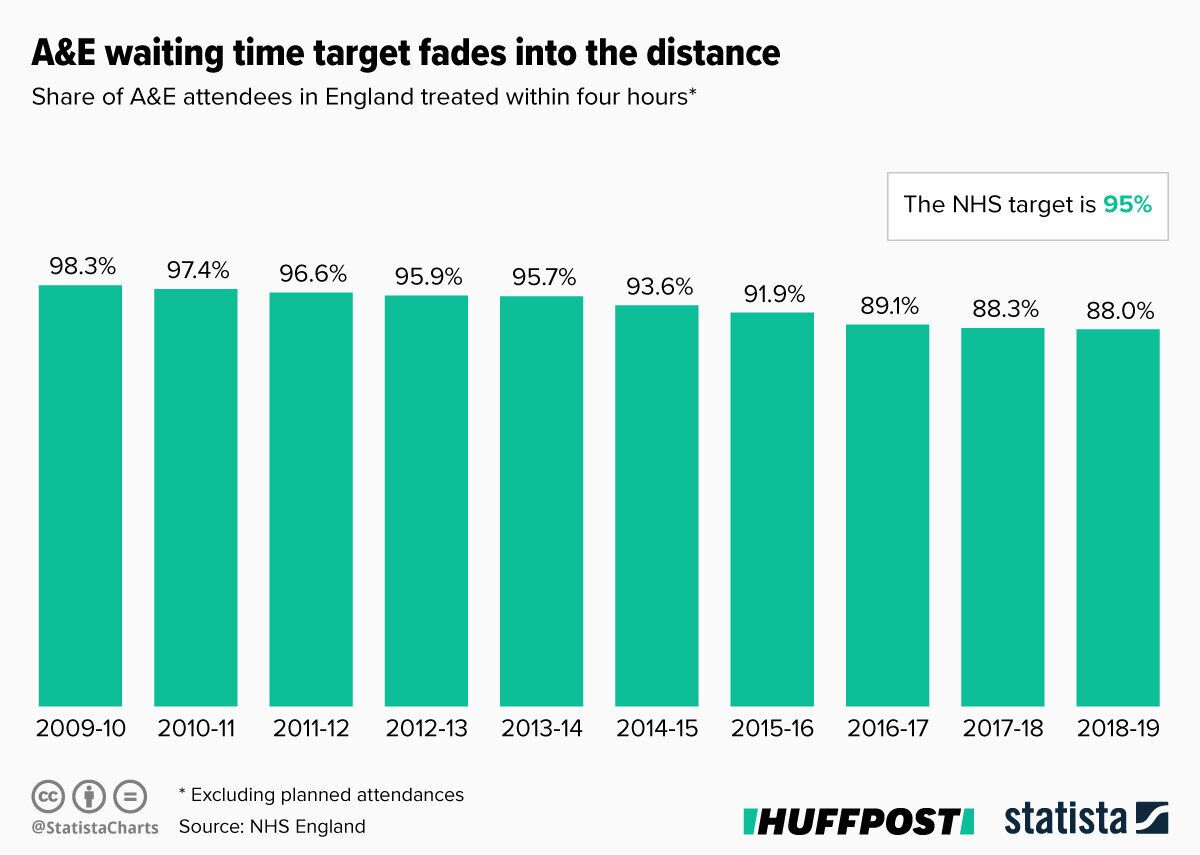
As one of the NHS’ most important frontline services, the way A&E departments perform is often used as a key indicator of the kind of stress the health services is under.
In November, A&E waiting times in England reached their worst level on record. Despite a target for 95% of patients to be seen within four hours, just 81.4% of people were dealt with in this time. It was the worst performance since the target was introduced in 2004.
But it was not a one-off. Annual average waiting times show that the percentage of A&E patients seen within four hours dropped by more than 10% between 2009/10 and 2018/19 – from 98.3% to 88%.
In fact, the last time the target was met was the summer of 2015.
But A&E Departments Are Under Far More Pressure Than They Were In 2010
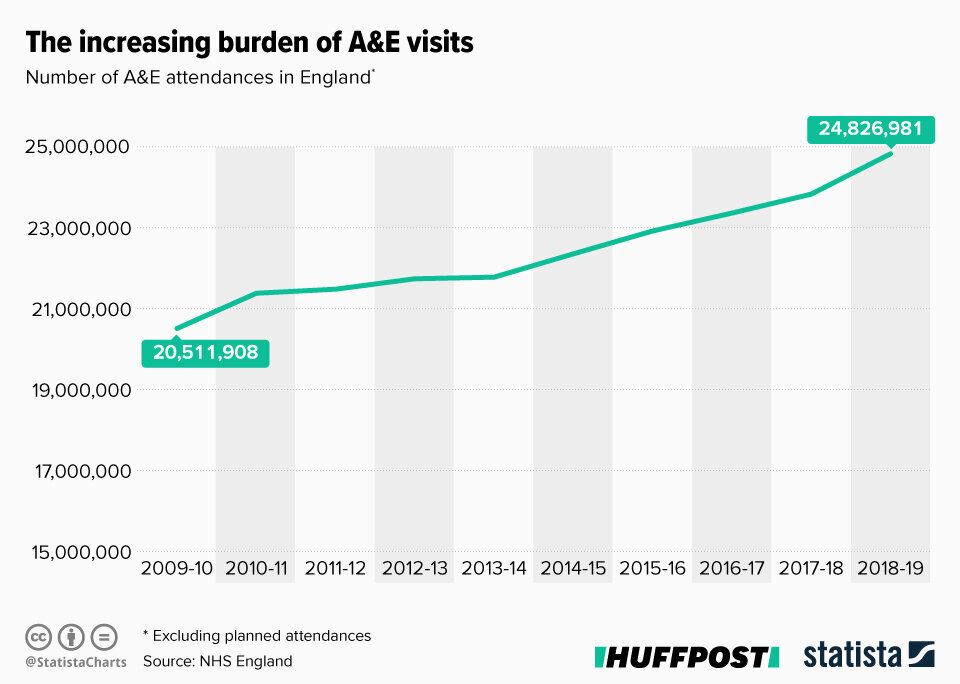
At first glance it would seem as if A&E waiting times have become worse over the decade – but these statistics mean nothing without context.
Since 2009/10, demand for accident and emergency services in England has increased massively.
At the start of the decade, there were around 20.5 million A&E attendances each year. By 2018/19, this figure had reached 24.8 million – a jump of 21%.
It essentially means that by the end of the 2010s, A&E departments were dealing with an extra 11,822 attendances every day.
But that’s not all. Between 2009/10 and 2018/19, the number of A&E patients dealt with within the four hour target actually went up by almost 1.7m.
So while waiting time targets tell one story, it’s important to look at the whole picture.
NHS England Also Failed To Meet Its Cancer Waiting Time Targets
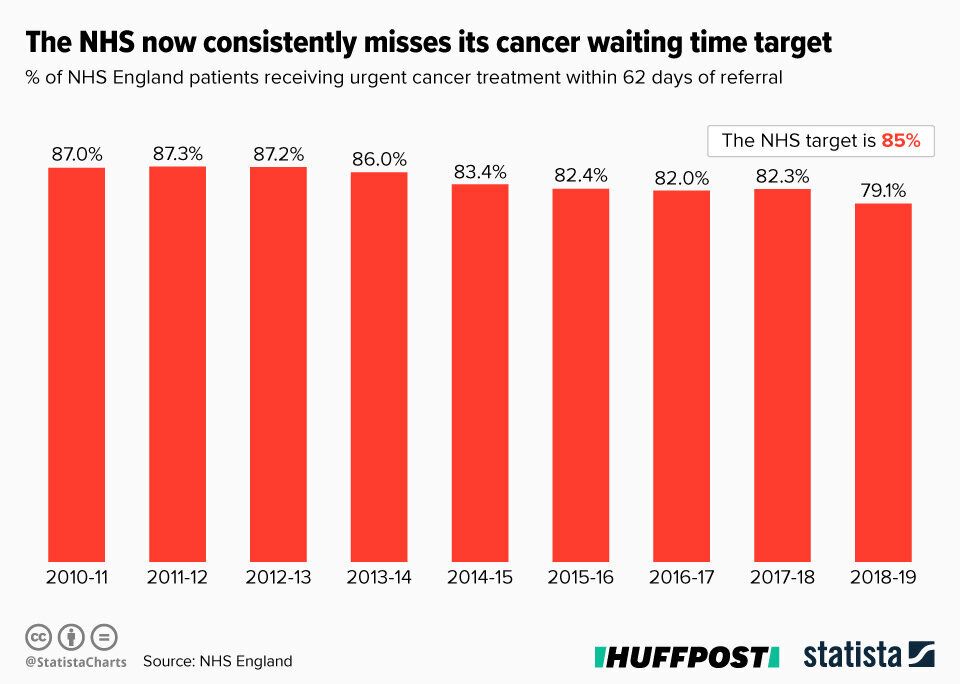
But it wasn’t just A&E waiting time targets that took a turn for the worse in the 2010s.
Under NHS England guidelines, patients who get an urgent referral from their GP because it’s suspected they have cancer should receive “definitive treatment” within two months (62 days).
But, according to NHS reports, this figure has not been met annually since 2013/14.
Between 2010/11 and 2018/19, the percentage of patients treated within this timeframe dropped from 87% to 79.1%.
However, the number of cancer patients given urgent referrals rose.
For example in October 2009, a total of 8,025 patients were urgently referred for treatment within two months, with 6,843 treated within the 62 day timeframe.
By October 2019, this figure had risen to 14,591. Meanwhile, the number of patients treated within two months was 11,246.
So while a smaller percentage of patients were treated within the target waiting time, thousands more were treated in this window.
Cancer Research’s policy manager Matt Case said “there just aren’t enough diagnostic staff to meet rising demand and many patients are still waiting too long for the care they need”.
“For anyone waiting for a cancer diagnosis or the all-clear, it’s an incredibly anxious time, and delays can make that worse,” Case said.
“Workforce shortages also make it harder to spot cancers at an earlier stage, which would give patients more treatment options and a better chance of long-term survival.”
The Number Of Urgent Operations Cancelled Each Year Jumped By Almost 12%
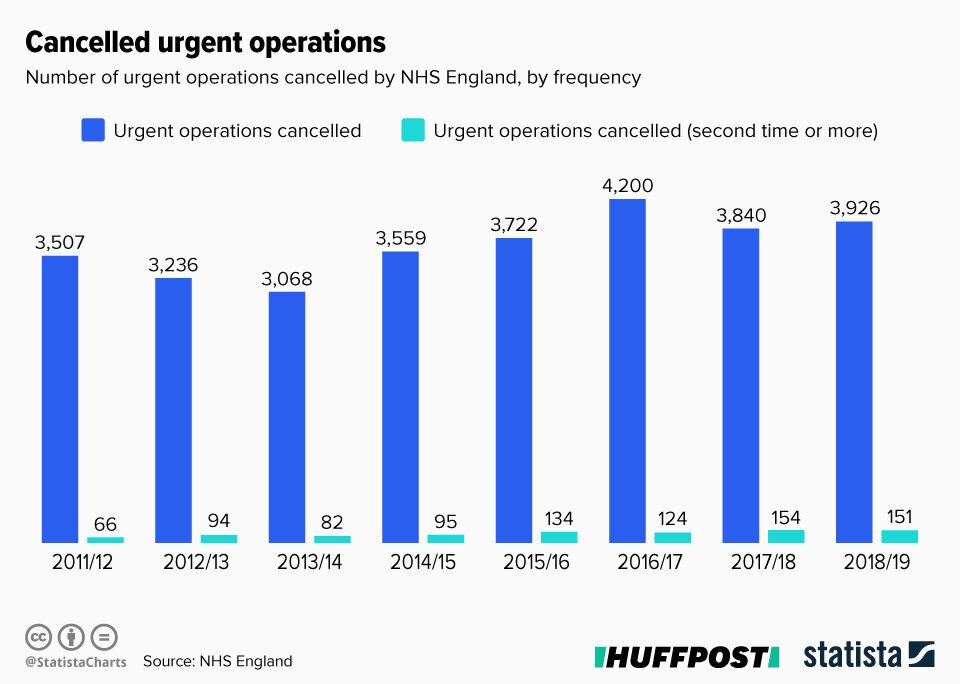
For patients in need of an urgent operation, it can be extremely stressful time. But between 2011/12 and 2018/19, the number of urgent surgeries cancelled in England jumped from 3,507 to 3,926 – a spike of 11.9% in just seven years.
During the same period, while the number of urgent surgeries cancelled more than once remained relatively low, the figure still rose steadily – from 66 to 151. It represents a rise of 129%.
NHS England doesn’t collect data about the overall number of urgent operations. However, according to a health service spokesperson, the best comparison is the number of emergency hospital admissions, as many of these patients will need urgent operations.
Between 2011/12 and 2018/19, the number of emergency admissions rose from around 5.1m to 6.4m – a jump of almost a quarter (24%).
The Rate Of Stillbirths Dropped
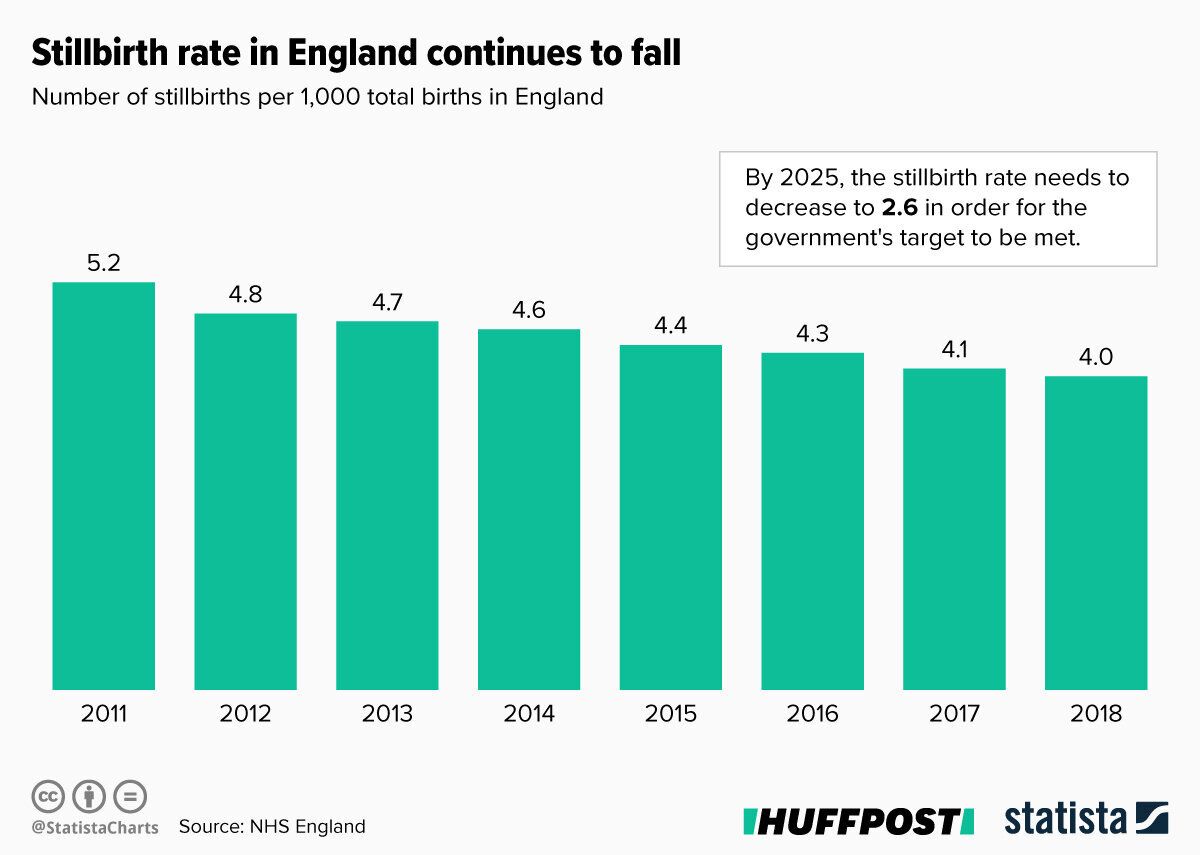
In some areas of the NHS, it would seem as if the health service has struggled to meet its targets during the 2010s.
But when it comes to the rate of stillbirths in England over the decade, there has been significant improvement.
According to data from the Office of National Statistics, in 2011 there were 5.2 stillbirths per 1,000 births.
However, after years of steady decrease, this figure fell to 4.0 stillbirths per 1,000 in 2018 – the latest available data.
In 2014, the government revealed a new ambition to reduce the rate of stillbirths by 50% in England by 2030 – a target which was brought forward to 2025 three years later. If the campaign is successful, the stillbirth rate will be 2.3 by then.
Speaking when the stillbirth figures for 2018 were announced, Jane Brewin – the chief executive of baby charity Tommy’s – welcomed the fall in the number of stillbirths.
She added: “But we need renewed momentum and new prevention strategies to bring rates down considerably further if we are to stay on track to meet the government’s ambition to halve these deaths by 2025.”
There Was A Spike In Some ‘Victorian Diseases’
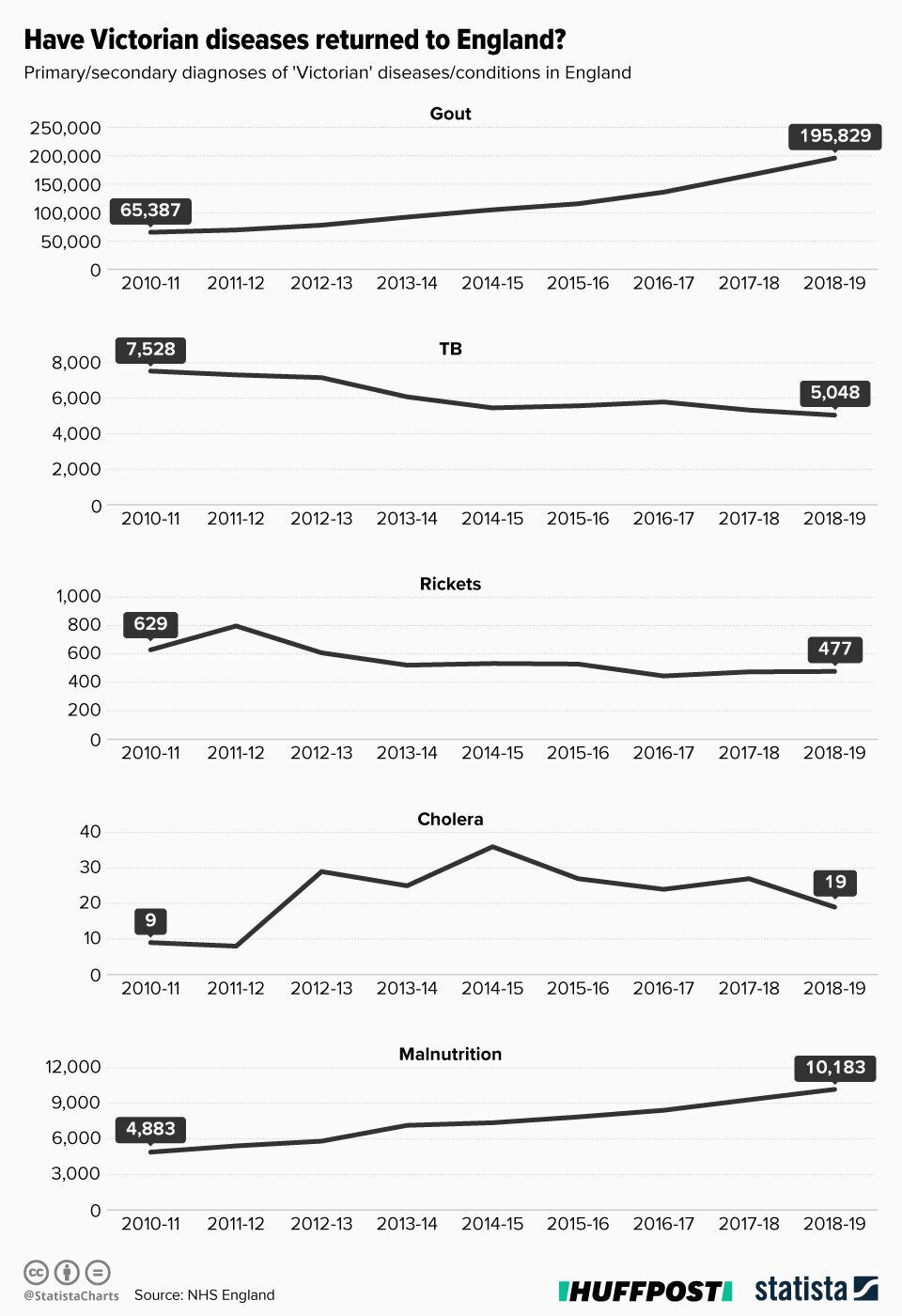
During the course of the decade, there was a rise in the number of admissions to hospital in England because people were suffering from ‘Victorian diseases’ – including gout, malnutrition, scarlet fever and scurvy.
The number of admissions for gout rose by almost 200% between 2010/11 and 2018/19, jumping from 65,387 to 195,829.
Meanwhile, there were 10,183 admissions for malnutrition last year, compared to 4,883 at the start of the decade. Admissions for scarlet fever also rose by 177%, while there were 133 extra admissions for scurvy (82 to 215).
However, cases of TB and rickets fell over the past 10 years.
But what about the 2020s? With a new government in place to kick off the new decade, how is the NHS likely to fare over the next 10 years?
During the election campaign, the Conservative Party not only promised £850m of funding to upgrade 20 hospitals, but committed to build 40 new ones.
Meanwhile, the Tories also promised 50,000 more nurses for the NHS – though this figure has come under much criticism, with the party counting 18,500 current NHS nurses that they plan to retain within the figure.
But, as the 2010s showed, it’s difficult to predict exactly how the NHS will fare over the next 10 years, with Britain’s exit from the EU adding to concerns about staffing levels.
Britain’s exit from the EU is also adding to concerns about staffing levels. Given that the government is likely to get its wish on the next January 31 deadline, chances are we might see what’s in store for the NHS sooner, rather than later.
